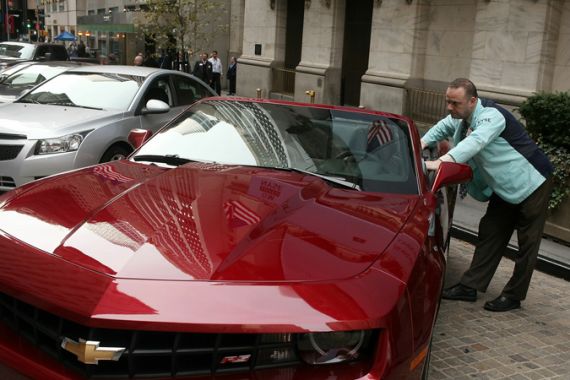GM automaker makes market return
US president hails end of government’s role as majority shareholder in car manufacturer as it raises $20.1bn.

General Motors returned to Wall Street on Thursday with a dramatic stock offering, ending the US government’s stint as the beleaguered auto giant’s biggest shareholder.
Including an option that would allow underwriters to sell more shares, expected to be exercised in coming days, GM looks set to raise $23.1bn, making it the biggest initial public offering in US history.
Keep reading
list of 4 itemsWhy is Germany maintaining economic ties with China?
Behind India’s Manipur conflict: A tale of drugs, armed groups and politics
China’s economy beats expectations, growing 5.3 percent in first quarter
“Going public is an important milestone on our way to being a new and different and better GM,” Dan Akerson, the GM chief executive, said.
Akerson, who rang the opening bell on the New York Stock Exchange to the sound of a revving engine on Thursday, said he was optimistic the initial public offering (IPO), initially priced at $33 per share, would be a success.
GM sold 478 million common shares, raising $15.77bn, as well as $4.35bn in preferred shares, more than the initially planned $4bn.
Shares rose nearly seven per cent in midday trade after a sale that could slash the government’s stake in the company from 61 per cent to as little as 33 per cent, recouping $11.7bn for taxpayers.
But Washington would need to sell the remainder of its shares at upwards of $50 per share – well above current market value – to recoup taxpayers money in full.
‘Tough decisions’
The company was forced to delist after filing for bankruptcy protection on June 1, 2009, amid plummeting sales, high debt and recession-hit consumers unable to secure loans.
GM’s stock then traded for less than a dollar.
The strong response to Thursday’s stock sale reflects investor confidence that GM is moving beyond its unpopular, taxpayer-funded bankruptcy with sharply lower costs and higher profit potential.
Barack Obama, the US president, pointed to GM’s rise from the ashes as proof his policies could work across the broader US economy, which is still struggling under the weight of high unemployment and tepid growth.
“We are finally beginning to see some of these tough decisions that we made in the midst of crisis to pay off and I’m absolutely confident that we’re going to keep on making progress,” he said.
“Last year we told GM’s management and workers that if they made the tough decisions necessary to make themselves more competitive … then we would stand by them.”
“And because they did, the American auto industry, an industry that’s been the proud symbol of America’s manufacturing might for a century, an industry that helped to build our middle class, is once again on the rise.”
Detroit cautious
However, Al Jazeera’s Imtiaz Tyab, reporting from Detroit where the automaker is based, said that the city’s residents were less upbeat about the chances that the company would completely recover.
“The jubilation and excitement that we saw on Wall Street certainly hasn’t translated here to Main Street,” he said.
“People are very happy that GM has returned to the stock market … but on the other side, you have many people saying, while investors have shown confidence in GM, will that translate into consumers showing confidence?”
|
“The higher that stock price is, the more money General Motors has got to invest in products, new facilities” Bob King, United Auto Workers president |
Automobile industry executives and analysts said the reversal in Wall Street sentiment towards GM pointed to revitalized hopes in an industry that was hard hit by the 2008 credit crisis.
That is a positive sign for a range of companies, including Chrysler, that are looking to tap the credit and equity markets in coming months, analysts said.
Bob King, United Auto Workers president, whose union stood to earn $3bn from the IPO for an affiliated trust fund for retiree healthcare, said GM factory workers had an interest in seeing shares perform well.
“The higher that stock price is, the more money General Motors has got to invest in products, new facilities,” King said.
The sale is already on target to beat the $19.7bn listing of Visa in 2008, which is the current US record.
The return of GM to the New York Stock Exchange after a near 18-month hiatus is expected to make it easier for the company to raise capital as it continues to address pension underfunding and shifts away from gas-guzzling sport utility vehicles (SUVs) toward greener, electric and fuel-efficient vehicles.
Whether bankruptcy fixed the company also remains a question, but it is far healthier in its new form.
The company closed 14 of its 47 plants, closed or sold off its Hummer, Saturn, Saab and Pontiac
brands, and slashed its debt from about $46bn to about $8bn.
Individual investors
More than 20 per cent of the IPO – or more than $3bn worth of stock – went to individual investors, making it the largest retail placement ever in value terms, a source said.
The IPO has been backed by a host of large US and international banks, including Morgan Stanley, Bank of America, JPMorgan, Deutsche Bank and two Brazilian banks.
Yet two banks – the Industrial and Commercial Bank of China [ICBC] and China International Capital Corporation [CICC] – stand out as they signal the first time Chinese government-owned banks taking part in a major US IPO, the IPO tracking firm Dealogic said.
Chinese state media said Shanghai Automotive Industries Corp [SAIC], GM’s partner in China, bought a one per cent stake in GM, to the tune of $500m.